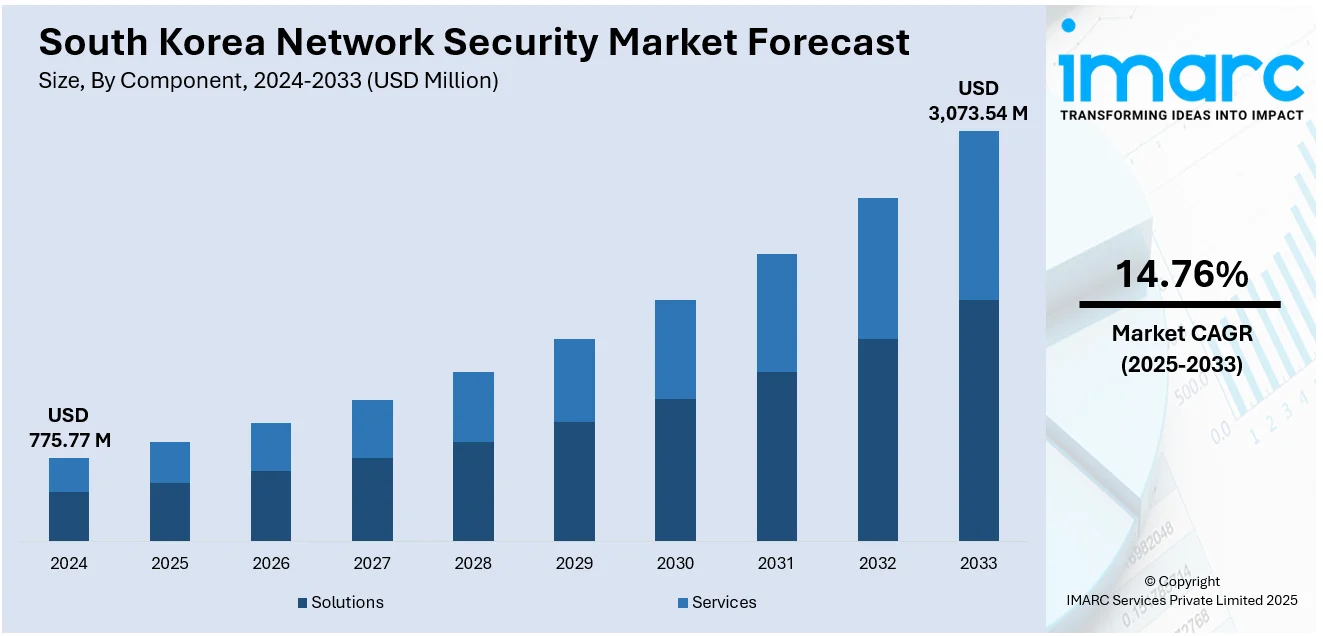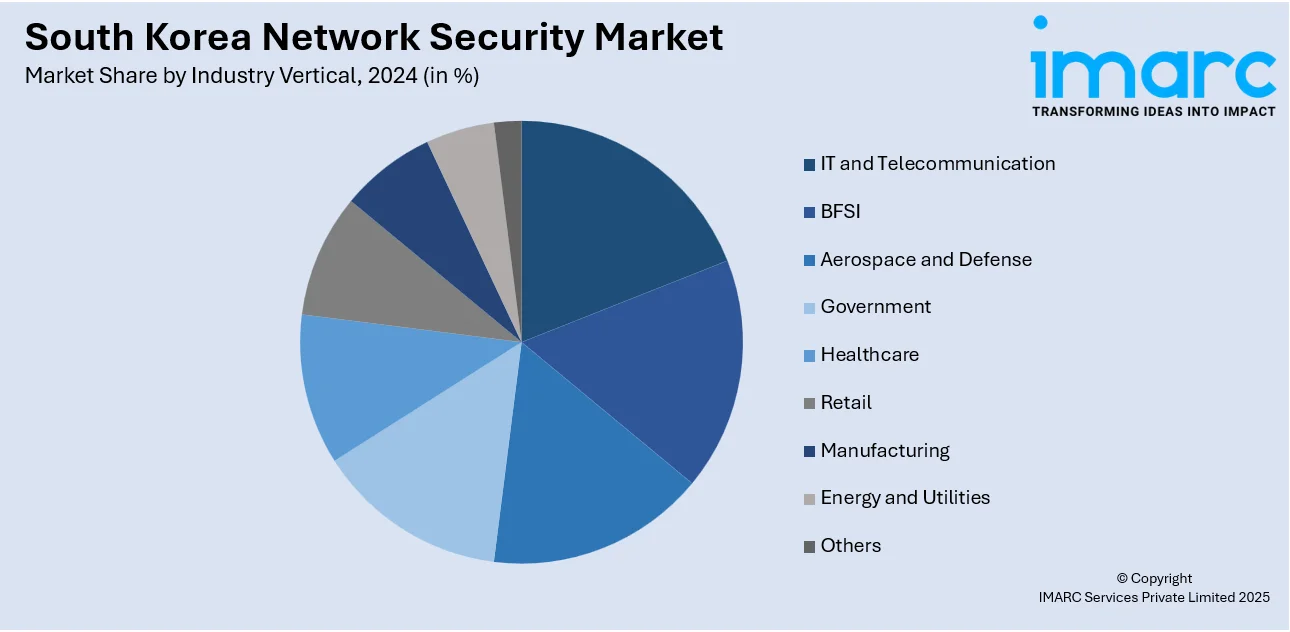
South Korea Network Security Market Size, Share, Trends and Forecast by Component, Deployment Mode, Organization Size, Industry Vertical, and Region, 2026-2034
South Korea Network Security Market Overview:
The South Korea network security market size reached USD 775.77 Million in 2025. The market is projected to reach USD 3,073.54 Million by 2034, exhibiting a growth rate (CAGR) of 14.76% during 2026-2034. Frequent cyberattacks like ransomware and data breaches are encouraging organizations to invest in advanced protection tools. Artificial intelligence (AI)-based solutions enhance threat detection, automate responses, and analyze patterns in real time, making security systems faster and smarter. Businesses across various sectors are adopting these technologies to safeguard sensitive data and ensure compliance, contributing to the expansion of the South Korea network security market share.
|
Report Attribute
|
Key Statistics
|
|---|---|
|
Base Year
|
2025
|
|
Forecast Years
|
2026-2034
|
|
Historical Years
|
2020-2025
|
| Market Size in 2025 | USD 775.77 Million |
| Market Forecast in 2034 | USD 3,073.54 Million |
| Market Growth Rate 2026-2034 | 14.76% |
South Korea Network Security Market Trends:
Increasing cases of cyberattacks
Rising cases of cyberattacks are positively influencing the market in South Korea. In April 2025, Mobile network provider SK Telecom, with around 34 Million users in the country, reported that it experienced a cyberattack where malware breached its internal systems and accessed information regarding customers' SIM cards. As more individuals and organizations are going digital, the threat of cybercrimes, such as data breaches, ransomware, and phishing, is growing rapidly. Businesses across sectors, especially finance, healthcare, government, and e-commerce, are facing increasing attempts by hackers to steal sensitive information and disrupt operations. These attacks not only cause financial loss but also damage reputations and user trust. As a result, companies are prioritizing investments in network security to protect their systems, data, and customers. Many organizations are adopting firewalls, intrusion detection systems, encryption tools, and endpoint security solutions to prevent unauthorized access. Cyberattacks are also becoming more sophisticated over time, catalyzing the demand for advanced tools supported by real-time threat detection. Small and medium-sized enterprises are recognizing the importance of strong cybersecurity measures due to rising risks. Public awareness and media coverage of cyber incidents are further highlighting the need for protection. Additionally, regulatory pressure from the government is encouraging businesses to comply with security standards, propelling the market growth. As the digital landscape is expanding, the demand for stronger and more adaptive network security solutions is escalating, making it a top priority for both the public and private sectors in South Korea

To get more information on this market, Request Sample.
Growing AI adoption
Rising use of AI is impelling the South Korea network security market growth. According to IMARC Group, the South Korea AI market size reached USD 3.12 Billion in 2024. As companies are integrating AI into services like finance, healthcare, manufacturing, and customer support, they are handling larger volumes of sensitive data and depend more on connected systems. This shift is increasing the importance of securing networks that support AI infrastructure. AI tools also rely on fast, stable, and protected data transmission, creating the need for advanced network protection. Additionally, AI adoption is encouraging cloud migration and automation, which require stronger network security to prevent disruptions and maintain trust. With South Korea’s focus on becoming a tech-oriented economy, industries are employing AI to improve efficiency and competitiveness. Government support for AI research and smart industry growth is adding momentum, driving the demand for secure, AI-compatible network environments. As AI continues to reshape operations and communication, the demand for strong network security frameworks is rising, ensuring stable and safe digital progress across South Korea’s economy.
South Korea Network Security Market Segmentation:
IMARC Group provides an analysis of the key trends in each segment of the market, along with forecasts at the country and regional levels for 2026-2034. Our report has categorized the market based on component, deployment mode, organization size, and industry vertical.
Component Insights:
- Solutions
- Firewalls
- Antivirus/Antimalware
- Network Access Control (NAC)
- Data Loss Prevention
- IDS/IPS
- Secure Web Gateways
- DDoS Mitigation
- Unified Threat Management
- Others
- Services
- Professional Services
- Managed Services
The report has provided a detailed breakup and analysis of the market based on the component. This includes Solutions {firewalls, antivirus/antimalware, network access control (NAC), data loss prevention, IDS/IPS, secure web gateways, DDoS mitigation, unified threat management, and others} and services (professional services and managed services).
Deployment Mode Insights:
- Cloud-based
- On-premises
A detailed breakup and analysis of the market based on the deployment mode have also been provided in the report. This includes cloud-based and on-premises.
Organization Size Insights:
- Large Enterprises
- Small and Medium-sized Enterprises
The report has provided a detailed breakup and analysis of the market based on the organization size. This includes large enterprises and small and medium-sized enterprises.
Industry Vertical Insights:

- IT and Telecommunication
- BFSI
- Aerospace and Defense
- Government
- Healthcare
- Retail
- Manufacturing
- Energy and Utilities
- Others
A detailed breakup and analysis of the market based on the industry vertical have also been provided in the report. This includes IT and telecommunication, BFSI, aerospace and defense, government, healthcare, retail, manufacturing, energy and utilities, and others.
Regional Insights:
- Seoul Capital Area
- Yeongnam (Southeastern Region)
- Honam (Southwestern Region)
- Hoseo (Central Region)
- Others
The report has also provided a comprehensive analysis of all the major regional markets, which include Seoul Capital Area, Yeongnam (Southeastern Region), Honam (Southwestern Region), Hoseo (Central Region), and others.
Competitive Landscape:
The market research report has also provided a comprehensive analysis of the competitive landscape. Competitive analysis such as market structure, key player positioning, top winning strategies, competitive dashboard, and company evaluation quadrant has been covered in the report. Also, detailed profiles of all major companies have been provided.
South Korea Network Security Market News:
- In September 2024, the National Security Council (NSC), established in South Korea, presented the National Cybersecurity Basic Plan, co-created with 14 governmental bodies, including the police force, intelligence agency, and the Ministries of Foreign Affairs, National Defence, and Science and ICT. The strategy detailed actions to improve the cyber resilience of essential infrastructure and key communication networks, which involved utilizing AI and segregating national and public networks from the internet and other lower-risk networks to establish a ‘multi-layered security’ framework.
South Korea Network Security Market Report Coverage:
| Report Features | Details |
|---|---|
| Base Year of the Analysis | 2025 |
| Historical Period | 2020-2025 |
| Forecast Period | 2026-2034 |
| Units | Million USD |
| Scope of the Report |
Exploration of Historical Trends and Market Outlook, Industry Catalysts and Challenges, Segment-Wise Historical and Future Market Assessment:
|
| Components Covered |
|
| Deployment Modes Covered | Cloud-based, On-premises |
| Organization Sizes Covered | Large Enterprises, Small and Medium-sized Enterprises |
| Industry Verticals Covered | IT and Telecommunication, BFSI, Aerospace and Defense, Government, Healthcare, Retail, Manufacturing, Energy and Utilities, Others |
| Regions Covered | Seoul Capital Area, Yeongnam (Southeastern Region), Honam (Southwestern Region), Hoseo (Central Region), Others |
| Customization Scope | 10% Free Customization |
| Post-Sale Analyst Support | 10-12 Weeks |
| Delivery Format | PDF and Excel through Email (We can also provide the editable version of the report in PPT/Word format on special request) |
Key Questions Answered in This Report:
- How has the South Korea network security market performed so far and how will it perform in the coming years?
- What is the breakup of the South Korea network security market on the basis of component?
- What is the breakup of the South Korea network security market on the basis of deployment mode?
- What is the breakup of the South Korea network security market on the basis of organization size?
- What is the breakup of the South Korea network security market on the basis of industry vertical?
- What is the breakup of the South Korea network security market on the basis of region?
- What are the various stages in the value chain of the South Korea network security market?
- What are the key driving factors and challenges in the South Korea network security market?
- What is the structure of the South Korea network security market and who are the key players?
- What is the degree of competition in the South Korea network security market?
Key Benefits for Stakeholders:
- IMARC’s industry report offers a comprehensive quantitative analysis of various market segments, historical and current market trends, market forecasts, and dynamics of the South Korea network security market from 2020-2034.
- The research report provides the latest information on the market drivers, challenges, and opportunities in the South Korea network security market.
- Porter's five forces analysis assist stakeholders in assessing the impact of new entrants, competitive rivalry, supplier power, buyer power, and the threat of substitution. It helps stakeholders to analyze the level of competition within the South Korea network security industry and its attractiveness.
- Competitive landscape allows stakeholders to understand their competitive environment and provides an insight into the current positions of key players in the market.
Need more help?
- Speak to our experienced analysts for insights on the current market scenarios.
- Include additional segments and countries to customize the report as per your requirement.
- Gain an unparalleled competitive advantage in your domain by understanding how to utilize the report and positively impacting your operations and revenue.
- For further assistance, please connect with our analysts.
 Request Customization
Request Customization
 Speak to an Analyst
Speak to an Analyst
 Request Brochure
Request Brochure
 Inquire Before Buying
Inquire Before Buying




.webp)




.webp)












